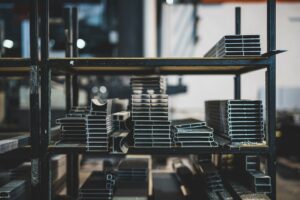Despite the current turmoil in the Ukraine/Russian war zone, South African steel supplies have not been badly affected, even though these warring countries are two of the world’s largest steel-producing and exporting countries – together accounting for some 20% of the European Union’s imports of finished steel products.
Nonetheless, the local steel industry still faces challenges of its own, which the Southern African Institute of Steel Construction (SAISC) is poised to assist with. This is according to Amanuel Gebremeskel, Technical Director at the SAISC. Steady SA steel supply “As the champion and voice of the steel value chain in South Africa – as well as those with an interest in the use of steel in all sectors of business and society as a whole – the SAISC has been observing the situation in the region. We are satisfied that the war in Europe will not create a local steel supply shortage – at least for the moment,” Gebremeskel advises. “It should also be noted that as a country, we are a primary steel producer ourselves, and an importer of steel from China – so there is still a steady supply of steel currently. Nonetheless, we are keeping a careful eye on the availability of supplies, and other local challenges which must be addressed,” he adds. In this vein, the Institute is focused on driving forward momentum, to assist the local steel industry in tackling its challenges and pivoting to make the most of new opportunities as the economy improves. “The SAISC is well-known as a custodian of steel industry knowledge and standards – from the creation and sale of popular technical publications, to offering training and assisting with technical queries relating to steel construction and structural engineering. We are proud of our willingness to innovate, adapt and be an industry trailblazer!” comments Denise Sherman, SAISC Marketing Director. Sherman points out that following two years of the global Covid-19 pandemic, and several years of steel sector difficulties prior to that – resulting in downsizing and significant job losses and hardship – the sector requires a champion now more than ever. ‘Voice’ of the industry Gebremeskel observes that the steel industry plays an important role in South Africa’s economy. “As such, the SAISC has been the sector’s official representative body – pioneering and championing its interests, innovation and development – since our founding in 1956,” he says, “and the Institute is respected for its reservoir of authoritative technical knowledge, and its role as the collective ‘voice’ of the steel construction industry.” In fact, with access to over 60 years’ worth of local steel industry project case studies, and an impressive number of experienced and highly-qualified team members, the SAISC is one of only 6 Institutes of its kind in the world – and an extremely valuable resource for the local steel industry. “It is our particular strength to be able to see the bigger picture, while liaising with role players and organisations across the steel value chain. From engaging with the primary steel producer, merchants and fabricators – to consulting with engineers, specifiers and architects on technology and design recommendations – we play a key role for decisionmakers across the steel industry,” he explains.The SAISC therefore encourages interested and eligible professionals to join as members – particularly engineers and fabricators – and also looks forward to partnering with an increased number of large engineering companies, which perform such a key role in building the nation.
“In this way, we hope to play a unifying role: helping South Africa to reindustrialise and thereby strengthening our economy. We are currently hard at work on one of the most important events in our annual calendar – the SAISC Steel Awards – which celebrates the use of steel in both industry as well as daily life, and showcases our role in fostering a spirit of innovation and a paradigm of excellence across South Africa’s steel value chain,” he advises. Remaining relevant and current Gebremeskel explains that before the pandemic, the SAISC was already looking at how it could improve its contribution to the industry and thereby the economy as a whole. “As South Africa moves into a post-Covid recovery phase,” he explains, “we are looking towards the future, and embracing new ways of interacting – as well as returning, where it is relevant, to those aspects of our operations that have worked optimally for us in the past.” Sherman adds that during the lockdown period, the SAISC and its members – like most organisations around the world – adopted a remote and digital way of working. “This model definitely kept the wheels turning during the first two years of the pandemic, and was a sign of how the SAISC is always willing to evolve in order to remain as a ‘business as usual’ operation during these difficult times,” she says. At the same time, this reflects that the SAISC was changing to keep pace with a younger average industry age of its engineers, and the onboarding of a new digital generation. The Institute is also revamping its website – making it more accessible, in line with its current digital and modernising drive. Nonetheless, industry has traditionally always enjoyed – and prospered – through in-person contact, Sherman concedes. “We have therefore already started implementing face-to-face meetings again, wherever possible. In essence, we are preparing to foster a hybrid future, in which we continue to embrace digital working, while preserving our strong heritage of facilitating in-person relationships and networking.” Local steel industry can ‘shine’ Sherman notes that the SAISC is very excited about playing its part in the reinvigoration and repositioning of the local steel industry. “The revitalising South Africa’s downstream steel industry is something that we strongly endorse. The steel industry as a whole is able to drive job creation and assist with the rebuilding of the economy.In fact, the South African steel industry has a real opportunity to ‘shine’, not just locally but in terms of being a primary steel producer and therefore being able to export steel, given the supply chain issues currently at play in Europe and the United States. We look forward to building on our proud history and our ongoing willingness to innovate, working together with our members, both current and those who are yet to join,” she concludes.







